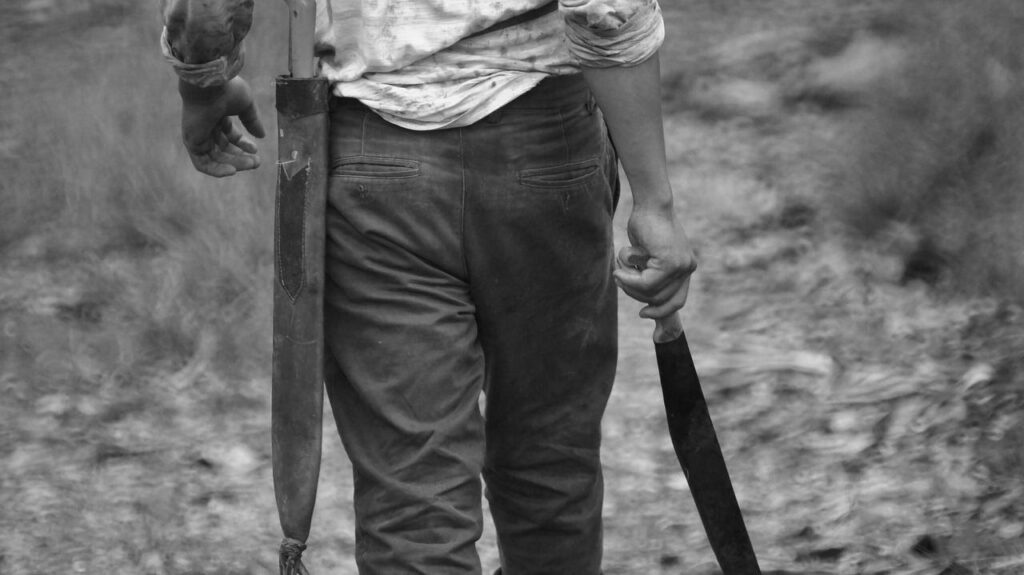
Survival machetes are built tough for tough jobs, but they can also manage outdoor tasks that require a lighter touch. Virtually every indigenous culture across the globe considers the machete a staple, and for good reason. Machetes are functional, affordable, and portable.
Not sure where to start on your search for the best machete? This guide is sure to help – feel free to reach out to our friendly customer service team, as well. We’re always happy to help guide a fellow machete fan to the ideal model.
Survival Machetes 101
The versatile machete, a large knife with a broad, thick blade, can be used for several practical purposes, from brush clearing to shelter construction. The word machete is derived from the Spanish word “macho,” which has two meanings: “manly” and “sledgehammer.”
What Is a Machete?
Not all wide-bladed tools are machetes. True machetes are at least 10 inches long and can be as long as two feet. Blade thickness is typically one-eighth of an inch, although you can find the occasional one-quarter inch blade.
Machete handles were traditionally crafted from hardwood—but today, machete handles are made with plastic, rubber, and fiberglass, too. Machetes are typically sharp on only one side, though there are double-edged machetes on the market. For example, the leaf-shaped “Smatchet.”
Why Are Machetes Important for Survival and Camping?
A machete is an indispensable tool for survival and camping. Not only can a machete clear brush and help you cut down wood for shelter, but it’s also a great tool for smaller and more delicate jobs like food preparation.
Early cultures used machetes to protect against wild animals, to gather food, and to aid in building shelters. Across the globe, machete-like tools were crafted to meet the unique needs of various cultures. For example, early machetes used throughout Latin America served different purposes than those used in Nepal. Their shapes and sizes reflected those differences.
Today, machete buyers have their pick of shapes and sizes, including machetes based around early tools like the Nepalese kukri, Japanese nata, and the Filipino bolo. Buyers are sure to find an ideal machete for just about any outdoor or survival task.
The Many Uses of the Survival Machete
Each machete style has certain strengths. Some are more appropriate for clearing jungle undergrowth, while others are designed to serve as multitools appropriate for a variety of survival tasks.
Trailblazing and Clearing Paths
Machetes are probably best known for how well-suited they are for clearing paths in the forest or jungle. The heft and length of the blade are ideal for cutting through small tree trunks, branches, bushes, grass, and weeds.
Constructing Shelters
You could use a survival knife to cut saplings and branches for construction material, but a machete can do this work in half the time and with much less effort. The versatile machete blade can even be used to shovel mud or snow for use in a makeshift shelter in bad weather conditions.
Chopping, Splitting, and Hammering
Coppicing—yes, that’s a real word—is the practice of cutting down many young tree stems in a row close to the ground. This encourages the growth of new shoots from the stumps, giving users a sustainable way to harvest wood for firewood, building material, charcoal, and more. Coppiced trees grow back more and more stems over time, a much more practical approach than clear-cutting a forest.
Machetes can be used for chopping compost into small pieces and to carve and incise wood. Incising wood, or preparing it to be treated, involves making many small cuts into wood, a process that is much more efficient with a machete than other woodworking tools.
Machetes make good hammers, as well. The wide, flat blade can be used to drive in nails and other fasteners.
Protecting Yourself From Animals
Machetes are safer and more effective for self-defense than weapons like survival knives. The longer blade keeps the wielder farther away from an attacking animal or a venomous snake and can be swung with greater force than shorter survival blades.
Harvesting Game
Machetes are good for work like scaling fish or skinning carcasses, though it takes practice and skill to become proficient. Skilled machete users can break down and butcher wild game of just about any size, from rabbits to large deer.
Harvesting and Foraging Plants
Machetes can be helpful when harvesting crops like rye, rice, millet, barley, buckwheat, oats, corn, and sugar cane. Sickle-style machetes are especially well-suited for these jobs. They can also be used to remove cover crops and dead plants located above ground vegetation without disturbing the underground roots.
Machetes can also be used to harvest berries, grapes, and other fruits and nuts. Once the harvesting is finished, the machete can be used to split nuts and fruit. The coconut is a classic example.
What to Look for in a Survival Machete
When you’re on the hunt for a quality survival machete, focus on how you plan to use it. If you’re looking for a machete to help you while camping in a less rugged area, you’ll want to focus on different machetes than someone looking for a true survival tool that can stand up to wild, harsh conditions.
As you learn how to pick a survival machete, learn about the machete’s six main parts—each of which you’ll want to consider carefully:
- Blade. The thicker and longer, the stronger but heavier.
- Handle. No matter what it’s made from, it should fit your hand securely and comfortably.
- Edge. The sharp side of the machete blade typically runs the entire length of one side, though you can find machetes with cutting edges on both sides.
- Spine. The back of the blade is typically flat but can be sharpened. Some have teeth for sawing.
- Tang. The back portion of the blade is covered by and attached to the machete handle. A full tang is generally better quality and offers more potential force and strength than partial tangs attached with epoxy.
- Pommel. The end or “butt” of the machete handle should be unobtrusive and balanced well, so it doesn’t affect the swing.
6 Excellent Survival Machetes
You can find machete types in a wide range of sizes and shapes to match your cutting needs and the local terrain. Generally, shorter blades have less reach but are lighter and more compact, though they are often not as sturdy as larger format machetes. High carbon stainless steel is more durable and stronger than regular stainless steel.
Below are 6 machetes that are a great choice for camping or survival:
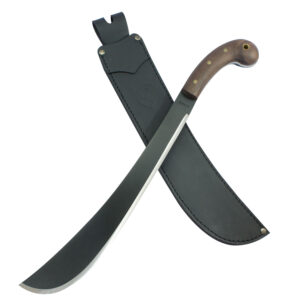
Parang
The parang machete has a distinctive, curved shape similar to a scimitar, where both the spine and blade edge is curved. Parang machetes are usually long and weighty, with a thick blade. Check out our parang machete lineup, including authentic Malaysian machetes with Bidor blades.
Place of Origin: Indonesia, Malay Archipelago
Uses: Cutting woody material
Also known as: Golok, Bedog, Sable
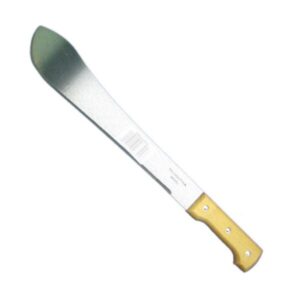
Bolo
The bolo machete is a popular machete used throughout Southeast Asia as an agricultural tool. This style of machete is ideal for harvesting narrow-row crops like rice and peanut because of its distinct bulge, which adds weight to the fore-blade for added chopping power. Machete Specialists has a full range of bolo machetes at every price point.
Place of Origin: Philippines, Southeast Asia
Uses: Harvesting crops and chopping woody vegetation
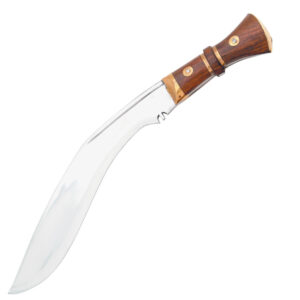
Kukri
The Kukri machete has a unique three-part construction: a pointed tip good for stabbing, a wide middle section ideal for chopping, and a more narrow section above the handle made for whittling and carving. Our extensive kukri machete selection offers something for everyone.
Place of Origin: Nepal, Central Asia
Uses: All-purpose
Also known as: Gurkha, Rawit
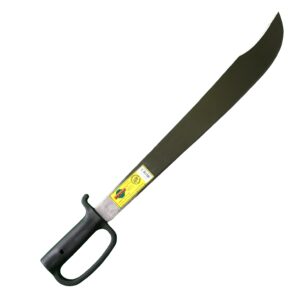
Bowie
The Bowie machete is popular among woodsmen and hunters thanks to its clip-point or skinner tip, which is well-suited for skinning wild game. Bowie machetes are named after Jim Bowie, the American frontiersman, and are among the best camping machetes. If you’re in the market for a Bowie machete built to last, you’re in the right place.
Place of Origin: United States
Uses: Utility, Hunting
Also known as: Large Bowie Knife, Survival Machete, Wilderness Machete
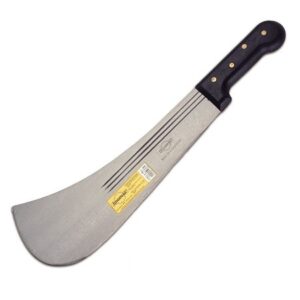
Panga
The panga machete has a deep belly that adds weight for chopping and a strong curve good for slicing. On the underside of the panga is a small area for piercing. Machete Specialists offers an extensive lineup of panga-style machetes.
Place of Origin: Africa
Uses: Slicing, chopping thick woody vegetation
Also known as: Borriquito, Daga, Liniero, Rozador
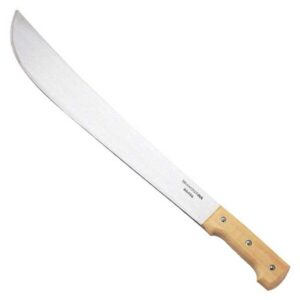
Bushcraft / Latin-style
Bushcraft machetes are solid all-purpose tools. This style of machete has a straight-back blade and is relatively short with a balanced weight. Bushcraft machetes are known for being very portable. Check out our popular bushcraft machetes.
Place of origin: Latin America
Uses: Cutting vegetation, all-purpose utility uses
Also known as: Latin-style Machete
Ready to Machete?
Machetes bring some of the best features of multiple blades to a single, portable tool. The machete can serve the purposes of an ax and a knife, offering excellent cutting and chopping capabilities. Every survival-minded woodsmen, hunter, or camper would be wise to keep a quality machete on hand.
MacheteSpecialists.com is your number one online source for machetes and machete accessories. We offer a wide range of highly-rated survival machetes and personalized, expert advice to ensure every buyer is matched with the best survival machete for the job at hand.
